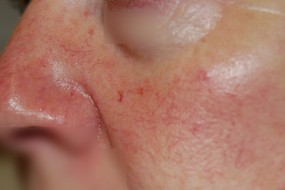April was designated as Rosacea awareness month by The National Rosacea Association to educate the public on this chronic skin condition. Today I wanted to discuss rosacea but also some tips which can help manage and control symptoms.
Rosacea is a chronic inflammatory skin condition which affects a high percentage of the population. It is considered to be chronic and without treatment will often progress. Although there is no known cure, there are plenty of options available to help reduce symptoms.
Common symptoms of rosacea include persistent redness, involuntary flushing, split capillaries, hot or itchy skin, papules or red bumps and dry eyes.
The onset of rosacea is typically from 30+ and symptoms tend to come and go. Rosacea can effect anyone but tends to be more common in fairer skins and women although symptoms are often worse in men.
The cause of rosacea is unknown but many sufferers will report certain triggers which can cause the inflammatory process to surface. These triggers vary from person to person but can include hormonal fluctuations such as menopause, excess oil production, stress, dietary changes and UV exposure.
Tips to help manage Rosacea
- Seek advice from a skin specialist who will advice the best treatment programme for your skin
- Wear a broad spectrum SPF every day
- Drink at least 1 ½ litres of water daily
- Keep a food and lifestyle diary and see if you notice any potential triggers. Some reported dietary triggers of rosacea include dairy, yeast, and highly acidic diets.
- Avoid sugary or processed foods
- Eat at least 5 potions of vegetables daily
- Eat plenty of omega 3 rich foods such as avocado and flax seed
- Include a probiotic supplement
- Anti-inflammatory ingredients applied to your skin daily can reduce symptoms. Great ingredients for rosacea include vitamins a & c which will help to balance and strengthen your skin .












